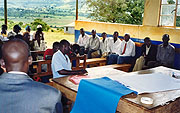 |








 |
 |

District-Level Institutional Innovations
One of AHI's key analytical thrusts is on "partnerships and institutional arrangements" for integrated NRM. By making this a core research thrust, institutional innovations assume equal importance as biophysical innovations in operationalizing INRM. At present, institutional partitioning of R&D institutions leads to a rather artificial conceptual partitioning of landscapes. Research organizations work independently from development organizations in designing strategies to bring change. At the same time, the organization of local government places responsibilities for water resource protection, agricultural production and conservation within independent institutions, thereby minimizing opportunities for collaboration and synergy. In some cases, the success of one institution may become the problem of another—as road construction contradicts "good practice" for soil and water conservation within ministries of agriculture, or promotion of fast-growing timber species by forest departments undermines water resource protection. Absence of procedures for joint planning and implementation also represents lost opportunities for harmonizing topical and geographical coverage, leading to duplications and inefficiencies in service provision. For R&D organizations to accelerate impact accruing from their interventions, institutional arrangement for working together are needed at site team and district levels.
While partnerships between research and development partners are part and parcel of AHI's work in all benchmark sites, the African Grassroots Initiative for Livelihoods and Environment (AGILE) has pioneered research on these institutional innovations. Focused on adapting the Landcare approach to eastern Africa, AGILE has fostered institutional innovations at community and district levels. While the former focuses on fostering collective action around priority innovations, the latter emphasizes partnerships with local government to operationalize a model for institutional cooperation.
 INSTITUTIONAL INNOVATIONS IN AGILE SITES INSTITUTIONAL INNOVATIONS IN AGILE SITES
 |
|
 |
DISTRICT INSTITUTIONAL INNOVATIONS

Farmer groups with prior conservation-related activities work with local government and AGILE facilitators to develop an
integrated land use plan at county level, Kapchorwa, Uganda.
 |
|
The AGILE approach takes institutions as the entry point for integrated NRM, with community-level innovations (technology testing and group management) facilitated by district-level R&D coalitions. At each level, key issues are identified and solutions sought through a collective and iterative prioritization, planning, implementation and review process. Targeted solutions may include policy reforms—as in the case of local by-laws on grazing rights in Kapchorwa, Uganda—or lobbying through the local government for national-level policy interventions. Joint planning and implementation, and the trust and organizational synergies created through this process, have enabled an AGILE-induced "infrastructure" to develop (Figure 1). This organizational structure enables communication and exchange of ideas among development partners, researchers and farmers, thus creating a conducive environment for identification and implementation of new development objectives and dissemination of farmer innovations.
Through the AGILE approach, R&D actors at district level have learned to appreciate the role of governance in NRM and the crucial role played by local communities and R&D actors at all levels in development. For example, local champions of AGILE have played a fundamental role in creating awareness for and implementing AGILE ideals within communities, resulting in the formation of "local chapters" that seek to inculcate these ideas into their community-based activities. In addition, there is growing realization of the great diversity existing within the community. This has in turn raised awareness on inclusiveness among various local interest groups, and enhanced recognition of vulnerable groups and of processes needed to guarantee their participation.
In AHI watershed and AGILE sites alike, a participatory, adaptive learning mode is used to facilitate improved management of natural resources following the concepts and principles of INRM to balance social, economic and environmental outcomes. This adaptive learning approach has led to the integration of new R&D actors who leverage the energy of existing groups, networks and institutions; linkages between farmers and existing resources and service providers for financial and technical support; and the building of a grassroots movement that empowers farmers to seek resources and needed policy changes. Innovations at District level are further linked at the national level through a National Landcare Chapter, enabling cross-site learning among AGILE groups in 3 pilot districts (Kapchorwa, Kabale, and Bundibugyo) through field visits, joint meetings and exchange of progress reports and methodologies.
 INSTITUTIONAL INNOVATIONS IN AHI WATERSHED SITES INSTITUTIONAL INNOVATIONS IN AHI WATERSHED SITES
Different from AGILE, the key entry point in AHI watershed sites has been largely technological. Subsequent institutional innovations have taken place at three levels: local, district and within national agricultural research institutions (NARIs). At the local level, farmer research groups have evolved to jointly test new technologies on their own farms, while watershed committees have evolved to address NRM priorities that cannot be addressed at the farm level alone. Other institutional innovations consist of negotiating change so that divergent local interests are considered and included in the watershed agenda. At district level, site teams have incorporated partners from extension, local government and other research institutions in implementing key aspects of the work for which they have a comparative advantage. While these actors have influenced the AHI agenda, this approach has been less successful than AGILE in influencing the agendas of partner institutions. Finally, institutional innovations are being tested within national research institutions that would enable key facets of the INRM approach tested in pilot sites to be institutionalized within the NARIs. A future challenge is to harmonize the AHI watershed approach, which has a strong grounding in integrated innovations at farm and landscape level, with the conceptual and methodological strengths of AGILE at district level. Lessons learned through self-led reforms of institutional structures, processes and procedures within partner NARIs of Tanzania, Ethiopia and Uganda could in turn be used to strengthen support given by partner institutions (local government, NGOs and research) to district-level institutional innovations.
 |
 |
|